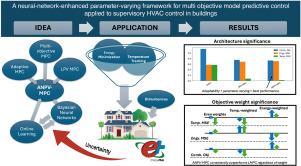一种应用于建筑物多目标模型预测控制的神经网络增强变参数框架
IF 9.6
Q1 COMPUTER SCIENCE, ARTIFICIAL INTELLIGENCE
引用次数: 0
摘要
由于替代能源发电技术的日益普及和电力负荷的日益多样化,电网的管理正变得更加复杂。这种复杂性给平衡需求和发电带来了挑战,可能会增加电网不稳定的可能性。解决这一问题的一个有效方法是通过先进的控制策略利用以前未开发的需求灵活性。在这项工作中,我们提出了一种先进的控制方法,称为自适应神经参数变化模型预测控制(ANPV-MPC),通过其采暖,通风和空调系统来控制建筑物的温度和能耗。ANPV-MPC结合了参数变控制、自适应控制和在线学习策略的关键思想,弥合了计算效率高的线性模型预测控制和更精确的非线性模型预测控制之间的差距。ANPV-MPC的新颖之处在于使用物理启发的贝叶斯神经网络来估计参数变化线性控制模型的系数。贝叶斯神经网络还提供不确定性估计,触发在线训练以捕获不断变化的建筑系统条件。研究结果表明,在不增加最优控制问题复杂性的前提下,ANPV-MPC能较传统线性模型预测控制提高28.39%的逼近精度,使控制性能提高36.23%。ANPV-MPC还通过在线学习实时适应以前看不到的条件,进一步提高其性能。本文章由计算机程序翻译,如有差异,请以英文原文为准。

A neural-network-enhanced parameter-varying framework for multi-objective model predictive control applied to buildings
Management of the electrical grid is becoming more complex due to the increased penetration of alternative energy generation technologies and a broadening diversity of electric loads. This complexity creates challenges in balancing demand and generation that can increase the potential for grid instabilities. One effective way to address this issue is to leverage previously unexploited demand flexibility through advanced control strategies. In this work, we propose an advanced control method, called adaptive neural parameter-varying model predictive control (ANPV-MPC), to control the temperature and energy consumption of a building via its Heating, Ventilation, and Air Conditioning system. ANPV-MPC combines key ideas in parameter-varying control, adaptive control, and online learning strategies to bridge the gap between computationally efficient linear model predictive control and more accurate nonlinear model predictive control. The novelty in ANPV-MPC is the use of a physics-inspired Bayesian neural network to estimate the coefficients of the parameter-varying linear control model. The Bayesian neural network additionally provides uncertainty estimates, triggering online training to capture evolving building system conditions. We show that ANPV-MPC can approximate the building system dynamics with a 28.39% higher accuracy than traditional linear model predictive control, resulting in 36.23% better control performance without increasing complexity of the optimal control problem. ANPV-MPC also adapts in real time to previously unseen conditions using online learning, further improving its performance.
求助全文
通过发布文献求助,成功后即可免费获取论文全文。
去求助
来源期刊

Energy and AI
Engineering-Engineering (miscellaneous)
CiteScore
16.50
自引率
0.00%
发文量
64
审稿时长
56 days
 求助内容:
求助内容: 应助结果提醒方式:
应助结果提醒方式:


